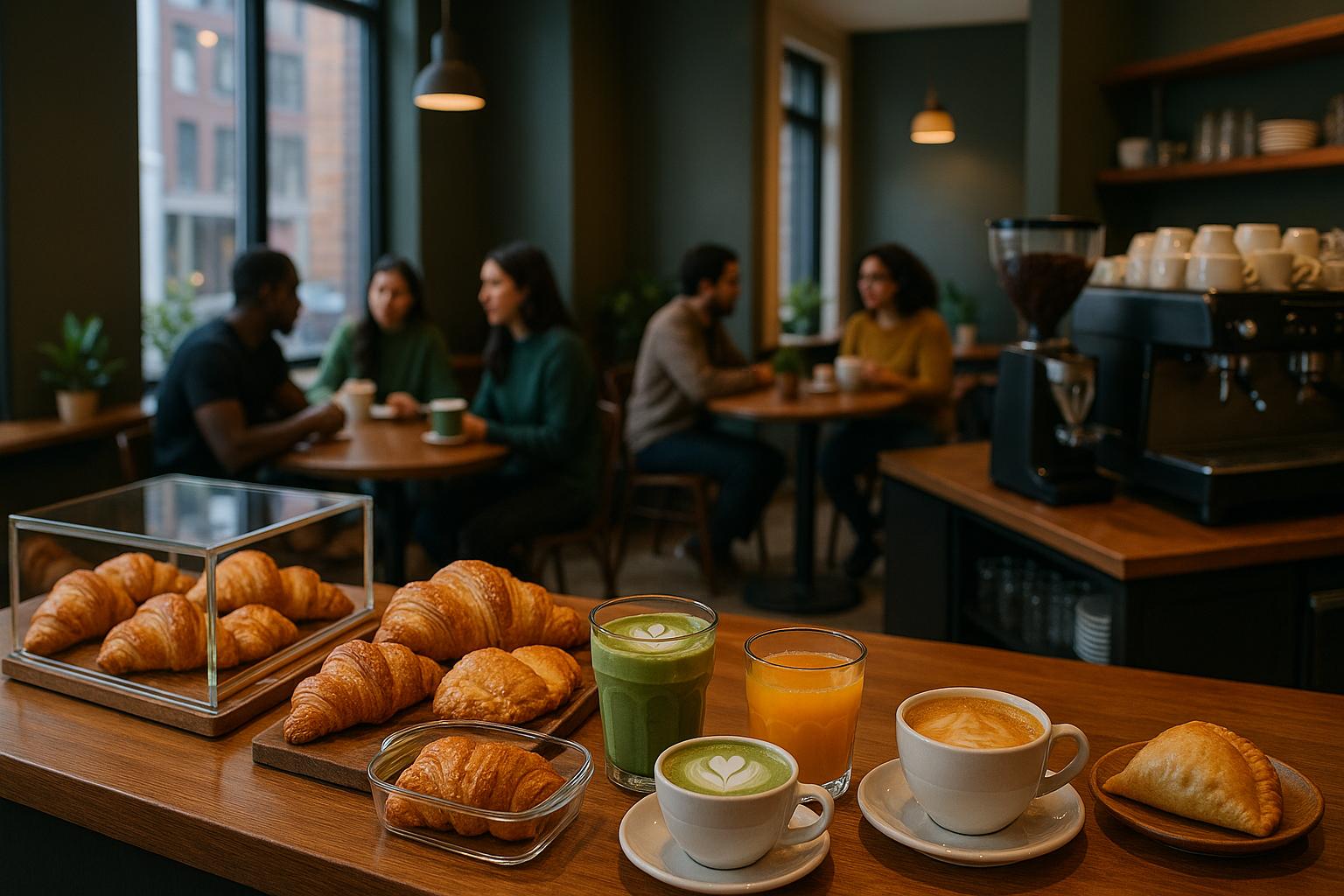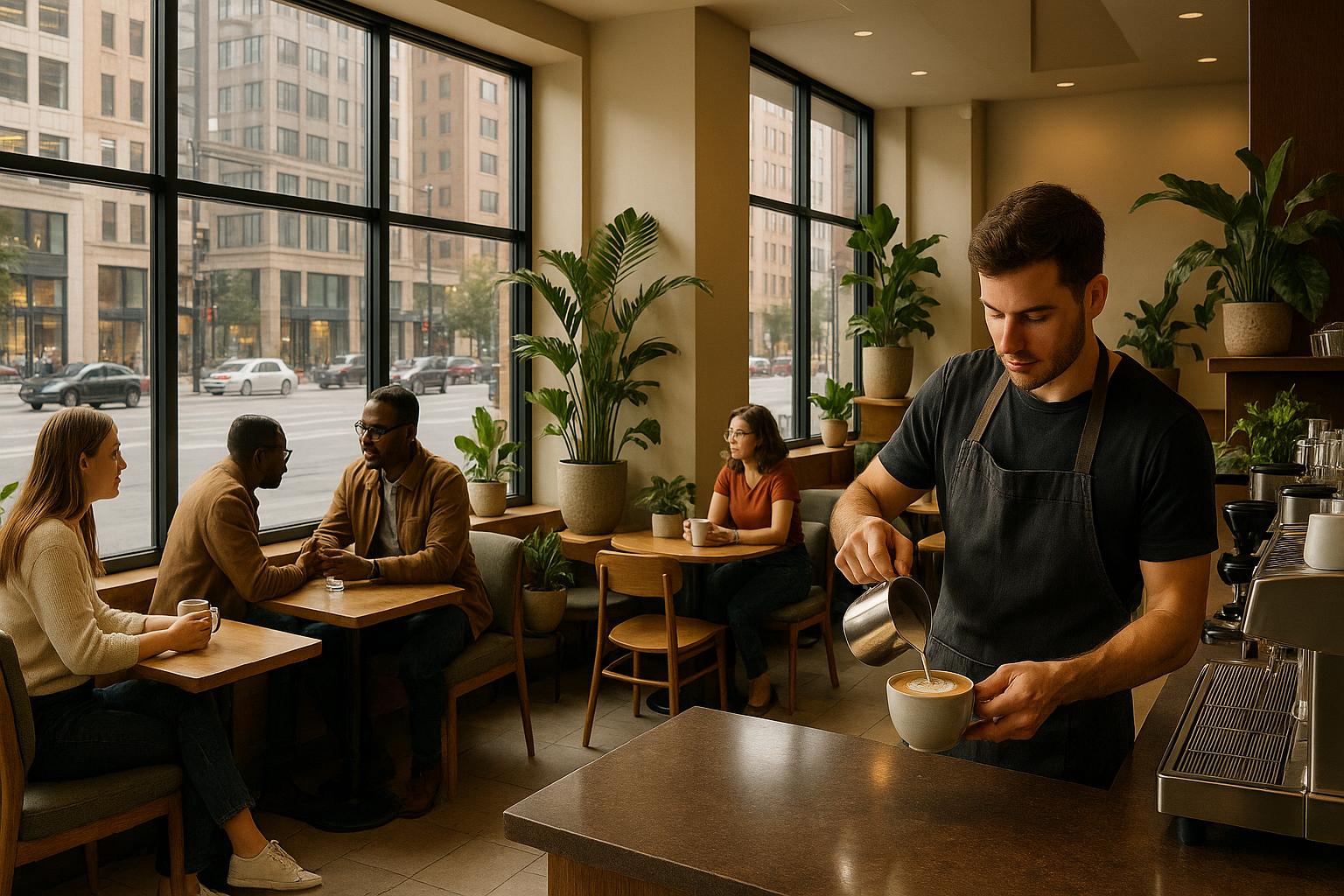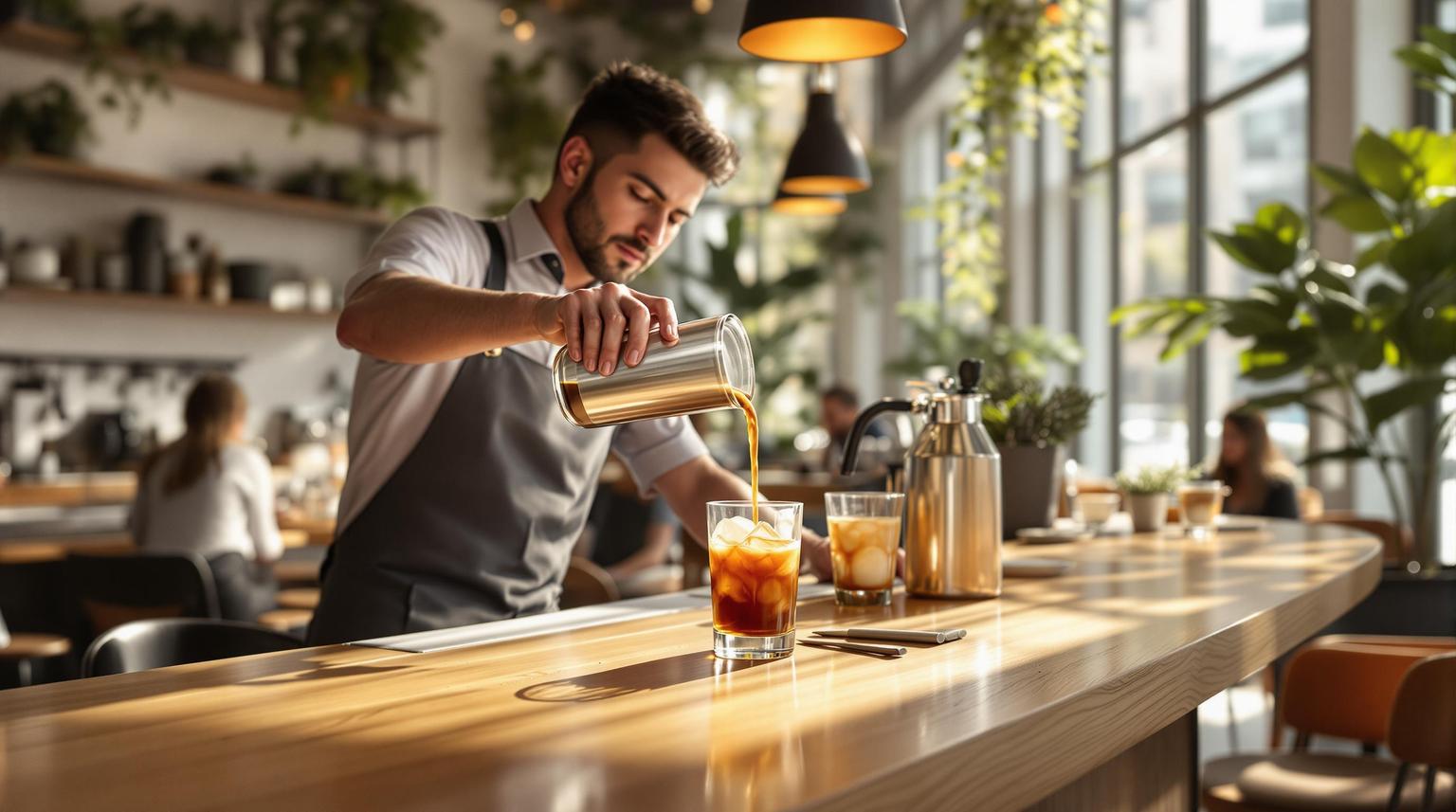Want strong coffee without the cost of an espresso machine? A Moka pot is your answer. This stovetop coffee maker has been a go-to since the 1930s, delivering bold, concentrated coffee. It’s affordable (around $25–$60), compact, and easy to use. Here’s a quick breakdown:
- What You Need: A Moka pot, medium-to-dark roast coffee beans, a burr grinder (or pre-ground coffee), filtered water, and a heat source.
- How It Works: Fill the bottom chamber with water, add coffee grounds to the filter basket, and heat. Steam pressure brews the coffee in minutes.
- Tips for Success: Use filtered water, avoid tamping coffee grounds, and remove from heat once brewing finishes to prevent bitterness.
Whether you’re making coffee at home or pairing it with local Chicago treats, a Moka pot is a simple way to enjoy rich, flavorful coffee every day.
5 Beginner Tips to Make PERFECT Moka Pot Coffee!
Tools and Ingredients You Need
Brewing coffee with a Moka pot is simple and requires just a few essential tools and ingredients. Here's everything you'll need to get started on crafting a flavorful cup.
Essential Tools
The Moka pot is at the heart of this process. A classic choice is the Bialetti Moka Express, known for its reliability and ease of use [1]. For individual use, a 3-cup model is ideal, while a 6-cup version works well for small households. If you’re using an induction cooktop, opt for a stainless steel Moka pot, as aluminum models won’t work. Gas and electric stoves, on the other hand, are compatible with any material.
For grinding coffee, a burr grinder is your best bet to achieve a consistent fine-to-medium-fine grind. If you don’t have one, high-quality pre-ground coffee designed for Moka pots or espresso can be a good alternative.
Keep heat-resistant pads handy to handle the hot pot, and a damp towel nearby to halt the brewing process when the coffee starts turning a yellow-honey color. This step helps prevent over-extraction.
A kettle for pre-heating water is another helpful tool. Pre-heating the water before pouring it into the Moka pot reduces the amount of time the pot spends on the stove, which can prevent the coffee grounds from "cooking" and developing bitter flavors.
When filling the filter basket, level the coffee grounds evenly, but avoid tamping them down. This ensures proper water flow during brewing.
Coffee and Water Selection
Choosing the right coffee and water is just as important as having the right tools.
Start with filtered water to enhance the flavor and minimize mineral buildup in your Moka pot. While tap water may be fine in some areas, like Chicago, its mineral content can affect the taste of your coffee and lead to residue over time.
For coffee, medium to dark roasts are ideal for Moka pots, as they produce a rich and bold flavor. Lighter roasts may come across as too thin or underwhelming for this brewing method. Check for beans roasted within the past 2–4 weeks; the roast date is often printed on the packaging.
Grind size matters. Aim for a texture similar to table salt - between fine and medium-fine. A grind that’s too fine can lead to over-extraction and bitterness, while one that’s too coarse may result in a weak, sour brew. If you’re using pre-ground coffee, look for options labeled specifically for Moka pots or espresso, as these are slightly coarser than traditional espresso grinds.
For the freshest flavor, grind your beans just before brewing. Ground coffee starts losing its aromatic compounds within 15 to 30 minutes. If you need to grind in advance, store the coffee in an airtight container and use it within a few days.
When filling the Moka pot, pour water into the bottom chamber up to the safety valve, and fill the filter basket completely with coffee grounds. This will help you achieve the ideal coffee-to-water ratio of about 1:7 to 1:8 for a perfectly balanced cup.
Step-by-Step Brewing Guide
Now that your tools and ingredients are ready, it’s time to make your first cup of Moka pot coffee. While the process is simple, paying close attention to each step will help you craft a rich, well-balanced cup.
Preparing the Moka Pot
- Fill the bottom chamber and insert the filter basket: Add water to the bottom chamber, stopping just below the safety valve. Place the filter basket into position and discard any excess water. Using hot water can speed up the process and help prevent the coffee grounds from overheating [2].
- Add the coffee grounds: Loosely fill the filter basket with coffee grounds, leveling the surface for even water flow. Be sure to wipe away any stray coffee particles from the rim to ensure a proper seal [5,9].
- Assemble the pot: Screw the top chamber onto the bottom securely. If the base is hot, use a towel to hold it - avoid gripping the handle to prevent damage [5,6].
Brewing on the Stove
Once the Moka pot is assembled, it’s time to brew.
- Heat the Moka pot: Place it on the stove over medium-low heat. This slower heating helps avoid a bitter or over-extracted brew.
- Keep an eye on the process: Leave the lid open so you can see the coffee as it brews.
- Listen for the sound: When you hear gentle bubbling or hissing and notice the coffee turning a honey or blonde color, remove the pot from the heat immediately. This prevents over-extraction and burnt flavors [10,11,12].
Serving and Enjoying
When the brewing process is finished:
- Cool the bottom chamber: Run the lower chamber under cold water right after removing it from the heat. This stops the extraction process [10,14].
- Pour and serve: Let the pot cool slightly, then pour the coffee while it’s still fresh and hot. Moka pot coffee is strong and concentrated - enjoy it as is, dilute it with hot water, or use it as a base for milk-based drinks.
- Stir for consistency: Give the coffee a quick stir before serving to ensure the flavor is evenly distributed in every cup.
sbb-itb-1371159
Troubleshooting and Beginner Tips
Making a great cup of coffee can sometimes feel like an art, but even the best baristas encounter hiccups. Here’s a quick guide to tackling common issues and improving your brew.
Common Mistakes and How to Fix Them
- Weak coffee: If your coffee lacks strength, try increasing the coffee-to-water ratio or ensure the filter basket is evenly filled.
- Bitter taste: Overly bitter coffee often points to over-extraction. Opt for coarser grounds or lower the brewing temperature to fix this.
- Slow or failed brewing: Check that your water temperature is right and your grind size matches your brewing method. A mismatch here can cause delays or stoppages.
- Overflowing or leaking: Double-check that all parts of your coffee maker are properly assembled. Inspect the gasket to ensure it’s intact and seated correctly.
- Coffee grounds in your cup: A damaged filter or gasket is often the culprit. Replacing these parts should solve the problem. [3]
Tips for Better Flavor
Fine-tuning your coffee-making process can elevate your brew to the next level. From experimenting with grind sizes to adjusting water temperature, small changes can make a big difference in flavor. Stay curious and keep tweaking until you find your perfect cup!
Enjoying Moka Pot Coffee in Chicago
Chicago's bustling café culture makes your homemade Moka pot coffee the perfect companion for exploring the city. Whether you savor your brew at home or venture out to discover local coffee spots, there's a special connection between the care you put into your coffee and the vibrant culinary experiences Chicago has to offer. This link not only enriches your coffee rituals but also deepens your appreciation for the city's dynamic coffee scene.
Discovering Chicago's Coffee Culture
Once you’ve perfected your Moka pot brewing skills, you might find yourself drawn to Chicago’s thriving craft coffee movement. Across the city’s neighborhoods, cafés celebrate the art of coffee in unique ways. A great resource to guide your exploration is BestCafeChicago.org, which provides a curated list of standout coffee spots. The site organizes its recommendations by neighborhood, specialty drinks, and user reviews, making it easy to find a new favorite.
From expertly brewed cold coffee to cozy, work-friendly environments, Chicago’s coffee scene has something for everyone. Neighborhoods like Lincoln Park, Wicker Park, and the Loop each offer their own flavor of coffee culture, giving you plenty of reasons to explore.
Perfect Pairings
Take your coffee experience a step further by pairing your Moka pot brew with some of Chicago’s local culinary delights. The rich, bold flavors of your coffee are a natural match for pastries and baked goods from neighborhood bakeries. BestCafeChicago.org can help you discover cafés and bakeries where you can experiment with pairings - whether it’s a flaky croissant or a decadent slice of cake. These combinations enhance not just your appreciation for your home brew but also your connection to Chicago’s vibrant food scene.
Conclusion
From understanding the tools to perfecting the technique, using a Moka pot blends tradition, affordability, and a personal connection to Chicago's vibrant coffee culture. This little pot unlocks a world of bold, concentrated coffee, linking you to a brewing method cherished for generations. With basic aluminum models priced around $25–30 [4], it's an accessible and eco-conscious alternative to high-priced espresso machines and wasteful single-use pods, helping you cut down on both costs and waste.
What makes Moka pot brewing special is the ritual itself. Each step invites you to slow down and savor the process, turning your daily coffee preparation into a mindful and rewarding experience. It's more than just making coffee - it's an art form that enriches your mornings.
If you're looking to refine your brewing skills, consider taking a "Home Brew" class at Counter Culture Coffee on Chicago's west side [6]. It's a great way to deepen your understanding and appreciation of the craft.
The Moka pot has earned its place in the hearts of coffee lovers, celebrated for its unique qualities and its ties to Italian-American heritage - a legacy that thrives in Chicago's rich coffee history [5]. With about 1.5 bars of pressure, compared to the nine bars of a traditional espresso machine [4], the coffee it produces has its own distinctive charm.
So, embrace the tradition and make the Moka pot a part of your coffee journey. Whether you're brewing at home or exploring the cafés of Chicago, your Moka pot skills will add a special touch to every cup. Dive into the rich flavors and history this little pot delivers, and connect with the city's thriving coffee community - one brew at a time.
FAQs
What mistakes should I avoid when using a Moka pot for the first time?
When using a Moka pot for the first time, there are a few mistakes you’ll want to steer clear of. For starters, don’t overfill the water chamber - too much water can cause leaks or lead to overly bitter coffee. And here’s a key tip: never tamp the coffee grounds. Pressing them down can block the filter, making it hard for the coffee to brew properly.
Pay attention to your grind size, too. If the coffee is ground too fine, it might taste bitter, while grounds that are too coarse can leave you with a weak brew. It’s also crucial to check that the safety valve is clean and functioning. A clogged valve can create dangerous pressure buildup. Lastly, keep an ear out for that signature gurgling sound. The moment you hear it, take the pot off the heat to avoid burning the coffee or introducing unpleasant flavors.
By following these steps, you’ll be well on your way to enjoying a rich, delicious cup of coffee!
What is the ideal coffee-to-water ratio for brewing with a Moka pot?
The coffee-to-water ratio is crucial for nailing the flavor of your Moka pot brew. A good starting point is a ratio of 1:7 to 1:10 - that’s 1 gram of coffee for every 7 to 10 grams (or milliliters) of water. Adjusting within this range lets you customize the strength of your coffee. A lower ratio (more coffee, less water) delivers a bolder, more intense flavor, while a higher ratio creates a lighter, gentler cup.
Be careful not to overdo it - too much coffee can turn your brew bitter, and too little might leave it tasting weak and underwhelming. The sweet spot lies in experimenting until you find the balance that brings out the bold, rich character Moka pots are famous for.
Can I use a Moka pot on an induction stove?
If you want to use a Moka pot on an induction stove, make sure it’s designed for induction cooking. These versions usually feature a stainless steel bottom chamber since traditional aluminum Moka pots don’t naturally work with induction cooktops.
For aluminum Moka pots, you’ll need an induction adapter to use them effectively. Another option is to purchase an induction-compatible Moka pot, which is specifically built to work smoothly with these stoves and is easy to find.


